|
|
Teeth Whitening System Comparisons
|
|
There are a variety of products and methods on the market today that claim to deliver effective dental whitening. Some of these methods and products work better than others and some do not actually work at all. The important factors in whitening gels are the active ingredients, stabilizing ingredients, viscosity and reactivity. The most effective systems utilize Carbamide Peroxide in a concentration of 10% - 45%. For first-time, tray-based bleaching, formulas containing concentrations of 16% - 22% Carbamide Peroxide yield a great balance of results and comfort. For in-office or experience bleachers, a high-penetration formula of 35% - 45% are very effective. Listed below are the popular methods for at-home dental whitening and their easy-to-measure criterion to compare their effectiveness and value.
Dental Whitening Product Comparisons
|
Type of At-Home Whitening System
|
Effectiveness
|
Comfort
|
Ease of Use
|
Color Change
|
|
Premium ThermoForm
Tray Systems
|
Excellent
|
Excellent
|
Excellent
|
11 Shades
|
|
Inferior ThermoForm
Tray Systems
|
Good
|
Moderate
|
Good
|
9 Shades
|
|
Bleaching Click Pens
|
Good
|
Excellent
|
Excellent
|
8 Shades
|
|
Non-moldable Tray
Bleaching Systems
|
Poor
|
Moderate
|
Good
|
3 Shades
|
|
Whitening Strips
|
Moderate
|
Poor
|
Moderate
|
2 Shades
|
|
Whitening Sprays
|
Poor
|
Poor
|
Moderate
|
<1 Shade
|
|
Whitening Toothpastes
|
Moderate
|
Good
|
Good
|
<1 Shade
|
|
The bleaching tray is the most important component in a tray-based teeth bleaching system. There are a variety of bleaching trays on the market today. Most are sub-par. As a part of our ongoing research and development, we test virtually every other tray sold in today’s markets Unfortunately, most manufacturers do not use the latest technology, shapes and polymers to create their trays. They create trays from low cost materials and procedures without regard to efficacy, comfort and thermo-reactivity. This means that most trays are either too small, are incorrectly shaped, are made from inferior polymers and most do not create an effective and comfortable tray.
An effective tray-based whitening system must contain custom moldable bleaching trays for your teeth. The whitening gel is required to stay in contact with the surface of your teeth for a length of time in order to be effective. Without the use of a moldable bleaching tray you will see problematic and inconsistent results. There are two types of moldable bleaching trays, the ThermoForm (boil-n-bite) type and the ProLab professional lab-created type. Both are effective, but ProLab bleaching trays (made by your dentist) may be more convenient and comfortable to use, but are typically more expensive. Quality ThermoForm Whitening kits will provide you with a soft, low-heat, clear tray that is easy to form and comfortable to wear. Also, quality kits provide an additional bleaching tray. Sometimes a patient may destroy a bleaching tray during the molding process and it is always nice to have an extra one just in case.
There several important things to look for in a bleaching tray:
|
Before Molding |
|
After Molding |
|
Customizable - An effective bleaching tray should be moldable to the individual by either thermoforming (boil-n-bite) or impression-based formation. Size - A bleaching tray should be able to reach most or all of the teeth prior to thermoforming. Usually a tray should cover all but the last 2-3 molars. Shape - A tray should have the correct shape to allow for total coverage from the top of the tooth to the to bottom. This is important for the front of the teeth and somewhat important for the back of the teeth. Composition - The special polymer blend of a bleaching tray is very important. This will dictate the tray’s thermoforming properties and comfort when wearing. Clarity - The best bleaching trays will be a very clear color. This is so that you can see the distribution of gel when you place the tray over your teeth. With the boom in LED assisted bleaching, clarity is also very important. Clear polymer blends usually have the best thermoforming properties and soft, comfortable feeling when wearing. ThermoForming Properties - A tray needs to be able to be softened when placed in hot to boiling water. The best trays require a lower temperature to soften them and they tend to stay soft and comfortable after formation. Less adequate trays require higher temperatures to soften them and they tend to be hard and uncomfortable to wear.
Below is a comparison of the correct and incorrect types of bleaching trays.
|
Tray Photo
|
Features, benefits and Detriments
|
|
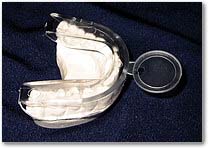
|
|
CORRECT (Sold Here)
ThermoForm Tray: The best ThermoForm Tray available. It covers most or all of the teeth and is completely clear so you can view your gel application. The clarity of a tray indicates that it has been made from proper thermoforming polymers that will soften at low temperature and provide the most precise impression of your teeth.
|
|
|
|
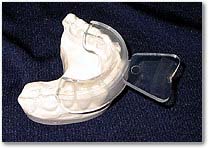
|
|
INCORRECT
ThermoForm Tray: Although this tray is somewhat clear, it does not cover all of the teeth prior to the molding process, which will shrink the tray even further. This tray will cause uneven whitening and should only be used for lightening the front teeth 1-2 shades.
|
|
|
|
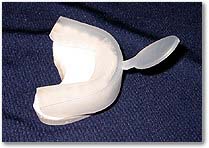
|
|
INCORRECT
ThermoForm Tray: This tray covers most of the teeth prior to molding, but does not pass the clarity test. It’s opaque color indicates that the polymer used in manufacture will only soften for molding at a very high temperature and not yield an accurate impression of the teeth. Also, It will not allow viewing of the gel application.
|
|
|
|
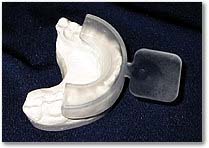
|
|
INCORRECT
ThermoForm Tray: This tray is the worst of both worlds and unfortunately, it is the most widely used in take-home bleaching kits. Not only is it too small, but but it also does not pass the clarity test. It is made from hard plastic and will not provide an accurate impression of the teeth.
|
|
|
|
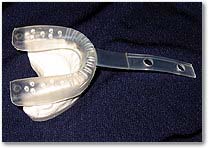
|
|
INCORRECT
Athletic Mouthgard: Believe it or not, some try to pass off an athletic mouthgard as a bleaching tray. These trays are made from a polymer that is unacceptable for dental bleaching and are designed to brace for impact, not provide uniform whitening. They can cause major problems like sensitivity reactions and pressure spotting (zebra teeth) if used for dental bleaching.
|
|
|
|
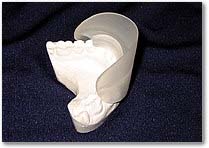
|
|
INCORRECT
Non-moldable Unitray: This tray is non-moldable, too small and does not pass the clarity test. This type of tray will cause non-uniform whitening and excessive sensitivities. This tray makes it difficult to talk, drink, and breath while wearing. It is for people who want to go through the motions of bleaching without real results.
|
|
|
|
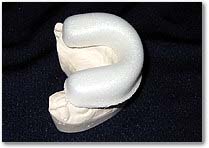
|
|
INCORRECT
Non-moldable Foam Tray: This tray is the latest fad in dental bleaching. It is non-moldable, too small and completely opaque. It is the absolute worst option for dental bleaching because the results are non-uniform and the sensitivities are extremely high.
|
|
|
|
There are a variety of dental bleaching gels on the market. Like dental bleaching trays, they all have varying degrees of efficacy. There are several important features of a bleaching gel to look for:
Active Ingredient - Carbamide Peroxide is the ingredient of choice because of its efficacy, safety, stability and shelf-life. This is the ingredient that most dentists prefer. Hydrogen Peroxide is also effective, but has a very short shelf-life and is not widely used for dental bleaching any longer.
Percentage of Active Ingredient - Carbamide Peroxide in the amount of 10% to 44% is used in dental whitening gel. Be sure to use a Carbamide Peroxide of at least 10% for dental bleaching. As a general rule, first-time bleachers should use a 16%-22% formula and begin treatment slowly until tolerance it built for the peroxide base. If a dental whitening formula does not list the percentage of Carbamide Peroxide on its label, assume it is a low powered formula that may be ineffective.
Viscosity - The thickness (or viscosity) of a gel is very important. An effective formula will be a medium to high viscosity (otherwise known as thick or sticky). This helps the gel stay on the teeth where it can do its work. The best gels strike a balance such that a gel can penetrate the pores of the teeth where staining occurs and stay in place long enough to oxidize stains.
Additive Ingredients - Other ingredients can be added to the bleaching formula. Some additive ingredients found are potassium nitrate, fluoride and assorted stabilizers. Our philosophy is to use a pure formula for dental bleaching without unnecessary additives since there are no studies showing the efficacy and long-term effects of such additives in combination with dental bleaching agents. If sensitivities are an issue, it is best to use a stand-alone desensitizing gel or toothpaste containing potassium nitrate.
The most important thing to look for is the active ingredient. You will prefer to use Carbamide Peroxide since it is highly effective and is the bleaching agent of choice in most dental offices. Some gels is made from unstable hydrogen peroxide, Beware, Hydrogen Peroxide has a very short shelf-life and must be stabilized with glycerin, making it less effective and creating more sensitivities. By the time a hydrogen peroxide gel is manufactured, distributed and finally used by the consumer, it may have little or no whitening power left. This is the main reason why Carbamide Peroxide gel is preferred. You can count on it having a shelf-life of up to two years if non-refrigerated or 3-4 years if kept refrigerated.
If a dental whitening system does not contain Carbamide Peroxide, it probably won't give you the results you want. Whitening gels contain from 10% to 44% carbamide peroxide. The most popular strength for tray-based bleaching is 22%. The higher the percentage of carbamide peroxide, the more powerful the formula. Be aware that a high percentage (above 22%) of carbamide peroxide in a tray-based bleaching method may cause unnecessary tooth and gum irritation. Also, buyer beware of any product that is delivered in unmarked containers or syringes with rubber plungers or tip-caps.
The most effective whitening gels are of a medium-high viscosity. In other words it should be thick enough to adhere to the teeth while being able to penetrate the teeth pores and oxidize stains properly.
Another consideration to be given to the formulation of dental bleaching systems is the addition of other active ingredients to the whitening gel. Other products may add flavorings or desensitizers to reduce discomfort of your mouth, gums or teeth during the bleaching process. We elected not to add desensitizers to our formula for very simple reasons. Sensitivity is your body’s way of telling you to reduce the exposure time to the bleaching agent or improper targeting of the gel. If you inhibit this natural warning buzzer, you may unknowingly increase your sensitivity reaction. Also, be aware if fluoride is contained in the whitening gel formula. It is against FDA regulations to formulate a whitening gel with fluoride since the FDA has not approved bleaching formulas containing fluoride.
|
Common Sense is not so Common!
|
|
Lastly, use common sense to purchase the right teeth whitening system for you. If you notice a ‘free trial’ offer, read the fine print. Free trials can cost you hundreds of dollars in the end. Also, if a product seems to be too cheap, there is a reason. It probably will not provide you with adequate results due to ineffective gels, improper materials used in bleaching tray manufacture, etc. Another complaint of at-home dental bleaching patients is that they did not receive enough whitening gel to get the job done. You must receive enough whitening gel to get your desired results. Most systems package the gel inside several syringes containing only 1.2ml to 3ml each (unlike the Oversized 5ml Syringes sold here). Be aware that most systems create the need for you to purchase multiple kits and/or refill gel in order to get enough whitening gel to see the results you desire. Make sure that you receive enough whitening gel to get the results you desire.
|
|